1987 TOYOTA CELICA warning light
[x] Cancel search: warning lightPage 9 of 346
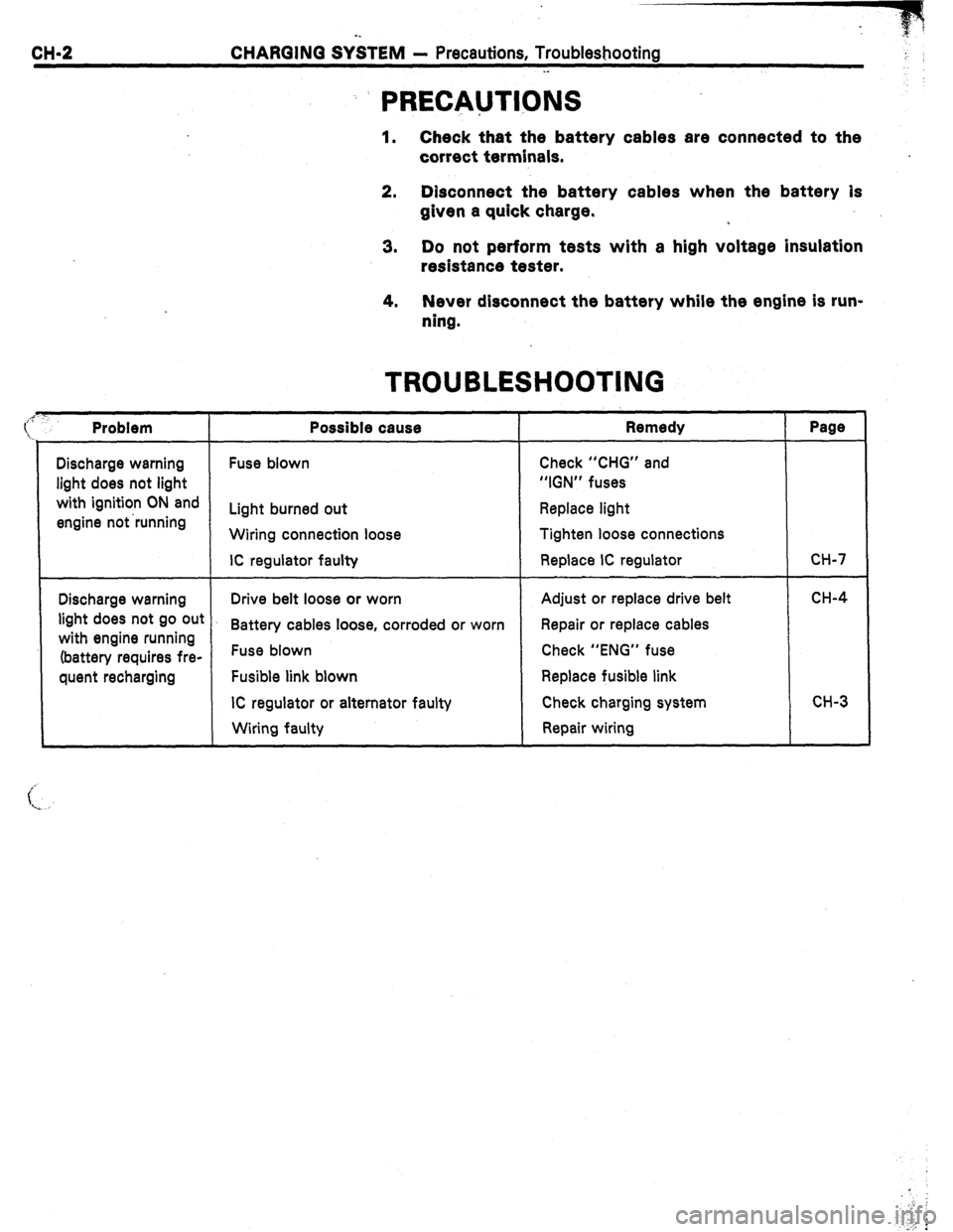
CH-2 CHARGING SY&EM - Precautions, Troubleshooting
._
: PRECAUTIONS
1. Check that the battery cables are connected to the
correct terminals.
2. Disconnect the battery cables when the battery is
given a quick charge.
3. Do not perform tests with a high voltage insulation
resistance tester.
4. Never disconnect the battery while the engine is run-
ning.
Discharge warning
light does not light
with ignition ON and
engine not ‘running
Problem
Discharge warning
light does not go out
with engine running
(battery requires fre-
quent recharging
Possible cause
Fuse blown
Light burned out
Wiring connection loose
IC regulator faulty
TROUBLESHOOTING
Remedy
Check “CHG” and
“IGN” fuses
Replace light
Tighten loose connections
Replace IC regulator
Drive belt loose or worn
Battery cables loose, corroded or worn
Fuse blown
Fusible link blown
IC regulator or alternator faulty
Wiring faulty Adjust or replace drive belt
Repair or replace cables
Check “ENG” fuse
Replace fusible link
Check charging system
Repair wiring
Page
CH-7
CH-4
CH-3
Page 37 of 346
![TOYOTA CELICA 1987 Service Repair Manual Circuit
Opening
Relay Fuel Pump Relay
“CHECK 1 f-- 1 ] : :
llll II :
: :
ENGINE”
Warning
Light ECU
I iIll
+-,llllllllllll
Electronic
Load Air Temp. Sensor
Check Connector 1 1 1 / 1 TOYOTA CELICA 1987 Service Repair Manual Circuit
Opening
Relay Fuel Pump Relay
“CHECK 1 f-- 1 ] : :
llll II :
: :
ENGINE”
Warning
Light ECU
I iIll
+-,llllllllllll
Electronic
Load Air Temp. Sensor
Check Connector 1 1 1 / 1](/manual-img/14/57451/w960_57451-36.png)
Circuit
Opening
Relay Fuel Pump Relay
“CHECK 1 f-- 1 ] : :
llll II :
: :
ENGINE”
Warning
Light ECU
I iIll
+-,llllllllllll
Electronic
Load Air Temp. Sensor
Check Connector 1 1 1 / 1 1 1 1 1 1 1 1
:uator
Igniter w/r-:’ ’
A/C Compressor
& 1 wTwy 1 To Charcoal Canister
Neutral Start
Switch (A/T)
Page 40 of 346
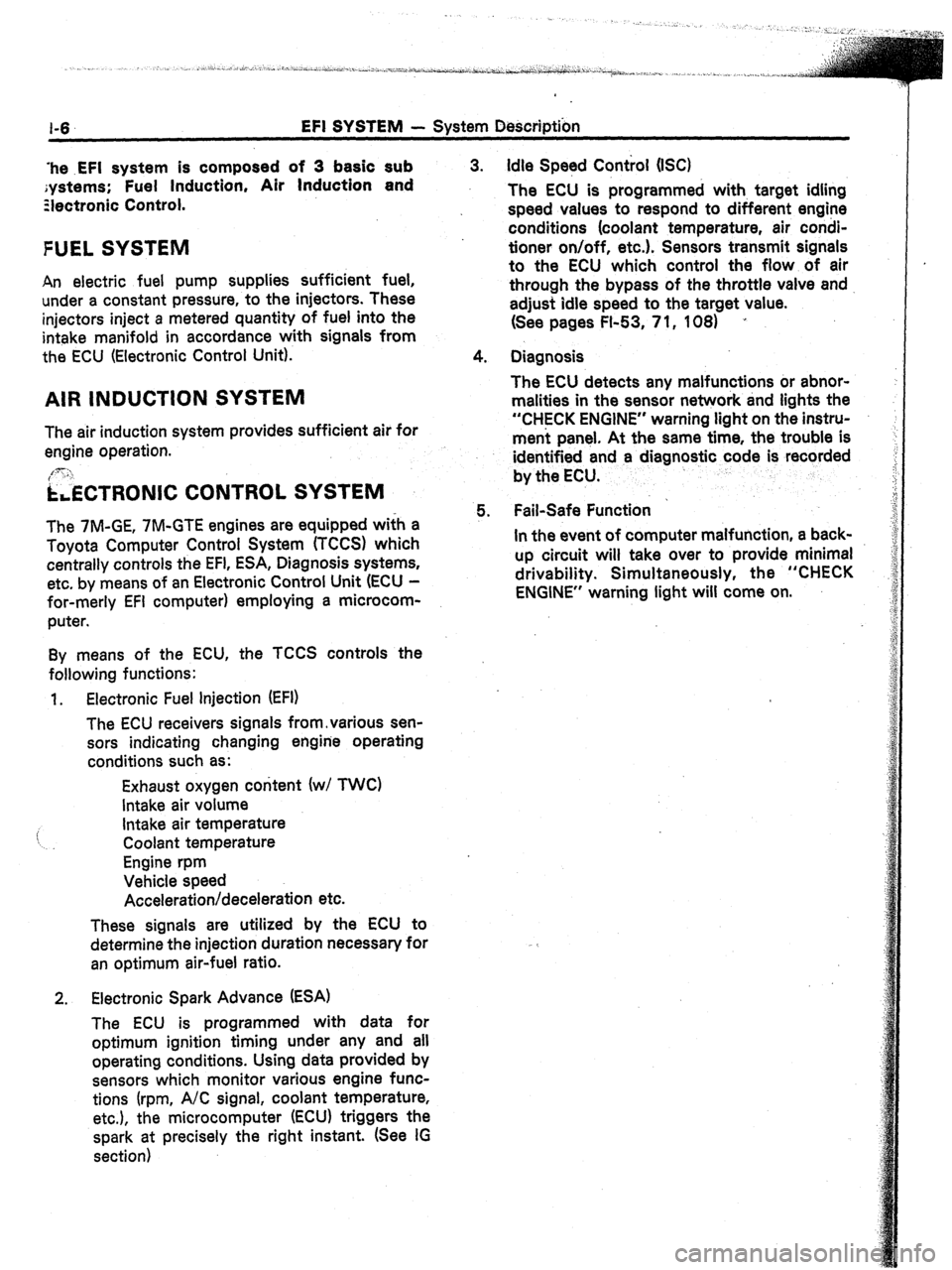
1-6 EFI SYSTEM - System Description
‘he .EFI system is composed of 3 basic sub
;ystems; Fuel Induction, Air Induction and
Ziectronic Control.
FUEL SYSTEM
An electric fuel pump supplies sufficient fuel,
under a constant pressure, to the injectors. These
injectors inject a metered quantity of fuel into the
intake manifold in accordance with signals from
the ECU (Electronic Control Unit).
AIR INDUCTION SYSTEM
The air induction system provides sufficient air for
engine operation.
[3: ‘I
i&TRONIC CONTROL SYSTEM
The 7M-GE, 7M-GTE engines are equipped wifh a
Toyota Computer Control System (TCCS) which
centrally controls the EFI, ESA, Diagnosis systems,
etc. by means of an Electronic Control Unit (ECU -
for-merly EFI computer) employing a microcom-
puter.
By means of the ECU, the TCCS controls the
following functions:
1. Electronic Fuel injection (EFI)
The ECU receivers signals from,various sen-
sors indicating changing engine operating
conditions such as:
Exhaust oxygen content (w/ TWC)
Intake air volume
i Intake air temperature
Coolant temperature
Engine rpm
Vehicle speed
Acceleration/deceleration etc.
These signals are utilized by the ECU to
determine the injection duration necessary for
an optimum air-fuel ratio.
2. Electronic Spark Advance (ESA)
The ECU is programmed with data for
optimum ignition timing under any and all
operating conditions. Using data provided by
sensors which monitor various engine func-
tions (rpm, A/C signal, coolant temperature,
etc.), the microcomputer (ECU) triggers the
spark at precisely the right instant. (See IG
section) 3. Idle Speed Control (IX)
The ECU is programmed with, target idling
speed values to respond to different engine
conditions (coolant temperature, air condi-
tioner on/off, etc.). Sensors transmit signals
to the ECU which control the flow of air
through the bypass of the throttle valve and
adjust idle speed to the target value.
(See pages FI-53, 7 1, 108) ’
4. Diagnosis
The ECU detects any malfunctions or abnor-
malities in the sensor network and tights the
“CHECK ENGINE” warning light on the instru-
ment panel. At the same time, the trouble is
identified and a diagnostic code is recorded
by the ECU.
5. Fail-Safe Function ’
In the event of computer malfunction, a back-
up circuit will take over to provide minimal
drivability. Simultaneously, the “CHECK
ENGINE” warning light will come on.
Page 59 of 346
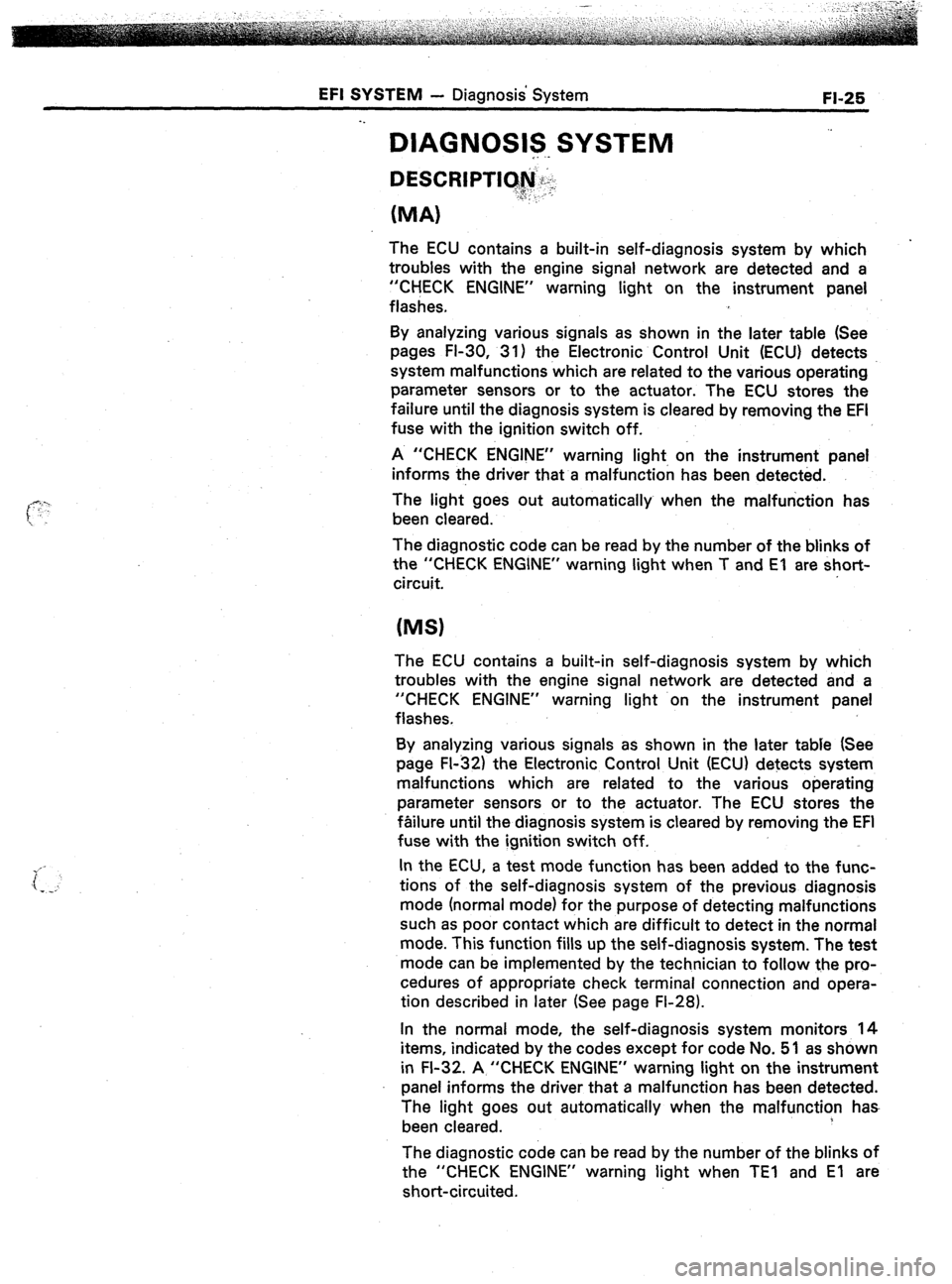
EFI SYSTEM - Diagnosis System
. .
DIAGNOSIS SYSTEM
__ --
FL25
(MA)
The ECU contains a built-in self-diagnosis system by which
troubles with the engine signal network are detected and a
“CHECK ENGINE” warning light on the instrument panel
flashes,
By analyzing various signals as shown in the later table (See
pages Fl-30, 31) the Electronic Control Unit (ECU) detects
system malfunctions which are related to the various operating
parameter sensors or to the actuator. The ECU stores the
failure until the diagnosis system is cleared by removing the EFI
fuse with the ignition switch off.
A “CHECK ENGINE” warning light on the instrument panel
informs the driver that a malfunction has been detected.
The light goes out automatically when the malfunction has
been cleared.
The diagnostic code can be read by the number of the blinks of
the “CHECK ENGINE” warning light when T and El are short-
circuit.
(MS)
The ECU contains a built-in self-diagnosis system by which
troubles with the engine signal network are detected and a
“CHECK ENGINE” warning light on the instrument panel
flashes.
By analyzing various signals as shown in the later table (See
page FI-32) the Electronic Control Unit (ECU) detects system
malfunctions which are related to the various operating
parameter sensors or to the actuator. The ECU stores the
failure until the diagnosis system is cleared by removing the EFI
fuse with the ignition switch off.
In the ECU, a test mode function has been added to the func-
tions of the self-diagnosis system of the previous diagnosis
mode (normal mode) for the purpose of detecting malfunctions
such as poor contact which are difficult to detect in the normal
mode. This function fills up the self-diagnosis system. The test
mode can be implemented by the technician to follow the pro-
cedures of appropriate check terminal connection and opera-
tion described in later (See page FI-28).
In the normal mode, the self-diagnosis system monitors 14
items, indicated by the codes except for code No. 51 as shown
in FI-32. A “CHECK ENGINE” warning light on the instrument
panel informs the driver that a malfunction has been detected.
The light goes out automatically when the malfunction has
been cleared.
The diagnostic code can be read by the number of the blinks of
the “CHECK ENGINE” warning light when TEl and El are
short-circuited.
Page 60 of 346
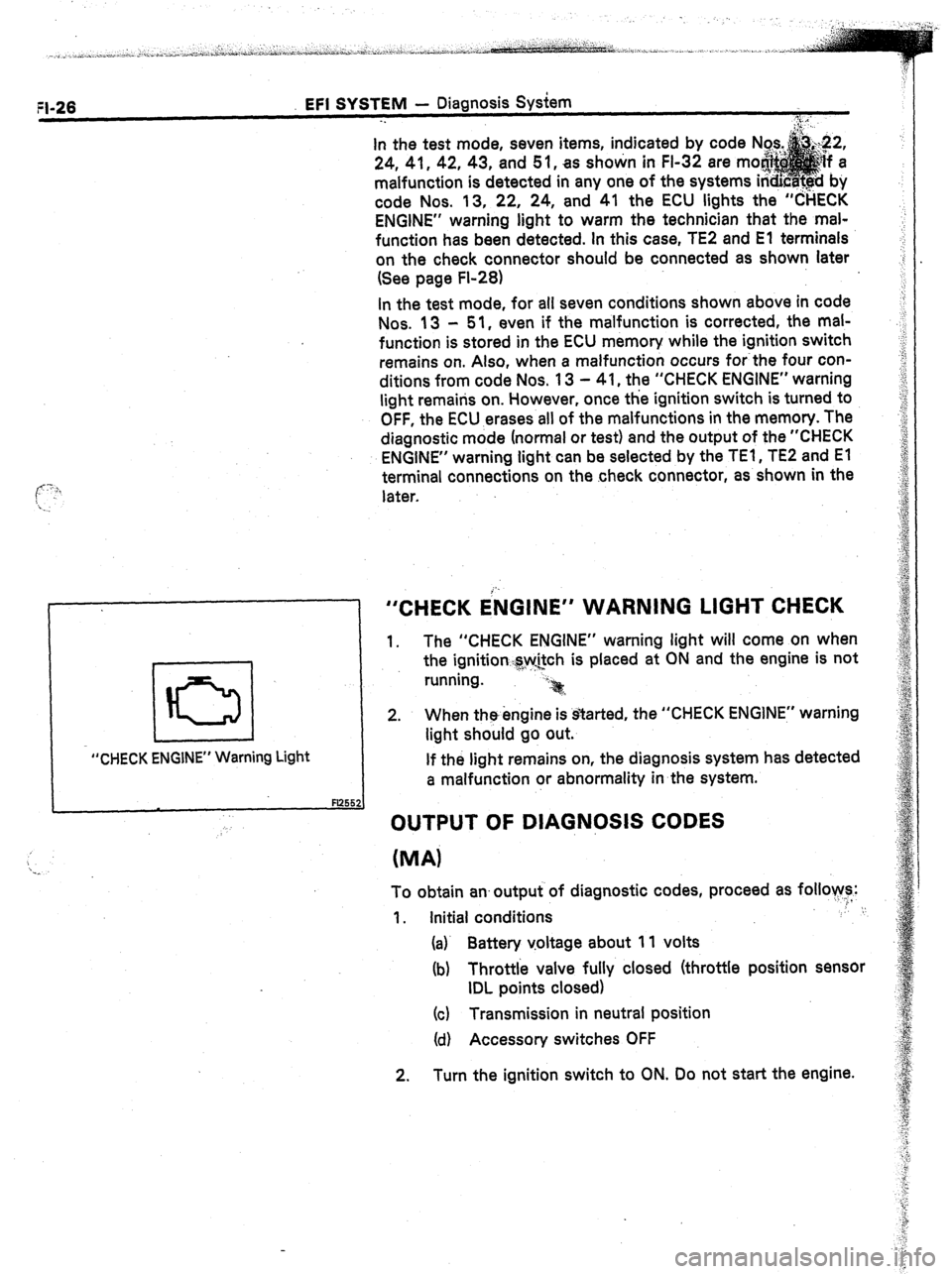
FI-26 EFI SYSTEM - Diagnosis System
-.
i
“CHECK ENGINE” Warning Light In the test mode, seven items, indicated by code
24, 41, 42, 43, and 5 1, as shown in FI-32 are m
malfunction is detected in any one of the systems
code Nos. 13, 22, 24, and 41 the ECU lights the “CHECK
ENGINE” warning light to warm the technician that the mal-
function has been detected. In this case, TE2 and El terminals
on the check connector should be connected as shown later
(See page FI-28)
In the test mode, for all seven conditions shown above in code
Nos. 13 - 51, even if the malfunction is corrected, the mal-
function is stored in the ECU memory while the ignition switch
remains on. Also, when a malfunction occurs for-the four con-
ditions from code Nos. 13 - 41, the “CHECK ENGINE” warning
light remains on. However, once the ignition switch is turned to
OFF, the ECU erases all of the malfunctions in the memory. The
diagnostic mode (normal or test) and the output of the “CHECK
ENGINE” warning light can be selected by the TEl , TE2 and El
terminal connections on the check connector, as shown in the
later.
“CHECK ENGINE” WARNING LIGHT CHECK
1. The “CHECK ENGINE” warning light will come on when
the ignitiorqw:@ch is placed at ON and the engine is not
running. -y.
2. When the engine is started, the “CHECK ENGINE” warning
light should go out.
If the light remains on, the diagnosis system has detected
a malfunction or abnormality in the system.
OUTPUT OF DIAGNOSIS CODES
(MA)
To obtain an output of diagnostic codes, proceed as follows:
1. Initial conditions ,’
(a)’ Battery voltage about 11 volts
(b) Throttle valve fully closed (throttle position sensor
IDL points closed)
(cl Transmission in neutral position
(d) Accessory switches OFF
2. Turn the ignition switch to ON. Do not start the engine.
Page 61 of 346
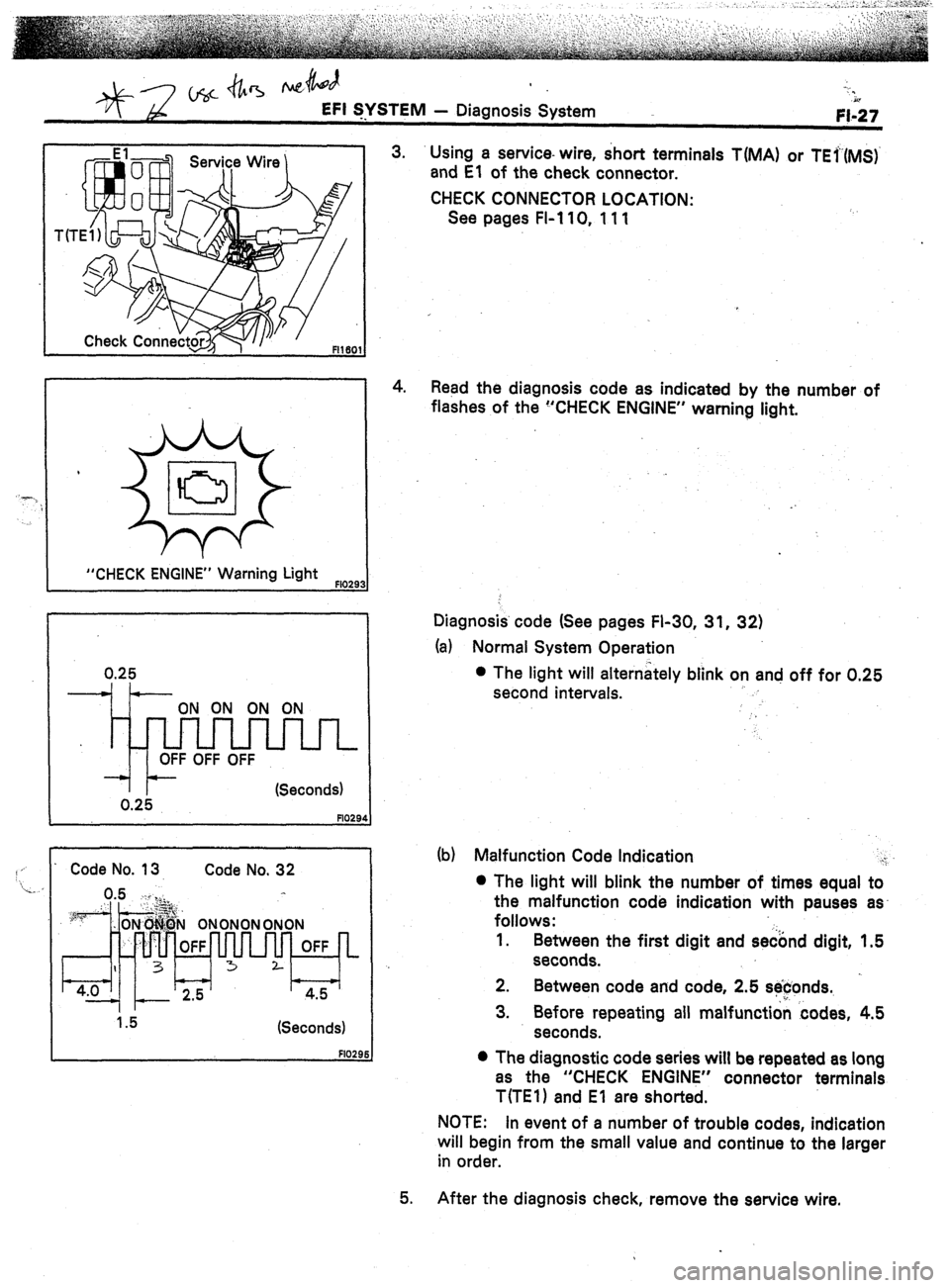
Osc db-5 hus 4J -7.
EFI SYSTEM w
-. - Diagnosis System
FI-27
“CHECK ENGINE” Warning Light FlO29
Code No. 13 Code No. 32
(Seconds)
3. Using a service- wire, short terminals T(MA) or TEr(MS)
and El of the check connector.
CHECK CONNECTOR LOCATION:
See pages FI-110, 111
4. Read the diagnosis code as indicated by the number of
flashes of the “CHECK ENGINE” warning light.
Diagnosis. code (See pages FI-30, 31, 32)
(a) Normal System Operation
l The light will alternately blink on and off for 0.25
second intervals.
.)
(b) Malfunction Code Indication i
l The light will blink the number of times equal to
the malfunction code indication with pauses as-
follows:
1.
Between the first digit and se&d digit, 1.5
seconds.
2.
Between code and code, 2.5 se$onds.
3. Before repeating all malfunction codes, 4.5
seconds.
0 The diagnostic code series will be repeated as long
as the “CHECK ENGINE” connector terminals
T(TE1) and El are shorted.
NOTE: In event of a number of trouble codes, indication
will begin from the small value and continue to the larger
in
order.
After the diagnosis check, remove the service wire.
Page 62 of 346
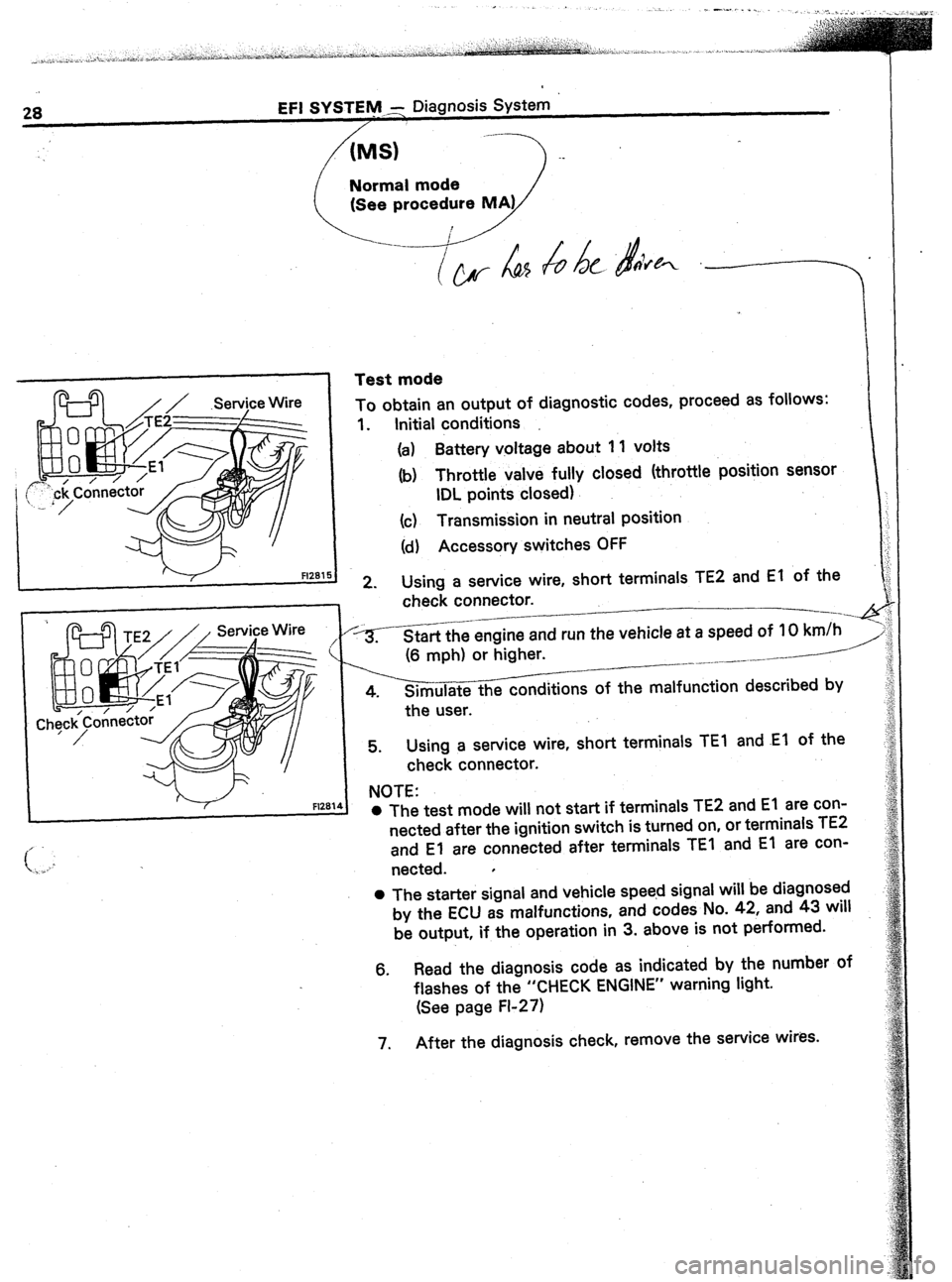
EFI SYSTEM; Diagnosis System
S)
------) -.
I Fl281
Test mode
i
To obtain an output of diagnostic codes, proceed as follows:
1. Initial conditions
(a) Battery voltage about 1 1 volts
(b) Throttle valve fully closed (throttle position sensor
IDL points closed)
(c) Transmission in neutral position
(d) Accessory switches OFF
2. Using a service wire, short terminals TE2 and El of the j
check connector.
-----.-q
*-heengine and run the vehicle at a speed of IO km/h I
(6 mph) or higher. __-- /---’
_ ___ _.--.--.
4. Simulate the conditions of the malfunction described by
the user.
5. Using a service wire, short terminals TEl and .El of the
check connector.
NOTE:
l The test mode will not start if terminals TE2 and El are con-
nected after the ignition switch is turned on, or terminals TE2
and El are connected after terminals TEI and El are con-
nected.
l
0 The starter signal and vehicle speed signal will be diagnosed
by the ECU as malfunctions, and codes No. 42, and 43 will
be output, if the operation in 3. above is not performed.
6. Read the diagnosis code as indicated by the number of
flashes of the “CHECK ENGINE” warning light.
(See page FI-27)
7. After the diagnosis check, remove the service wires.
Page 63 of 346
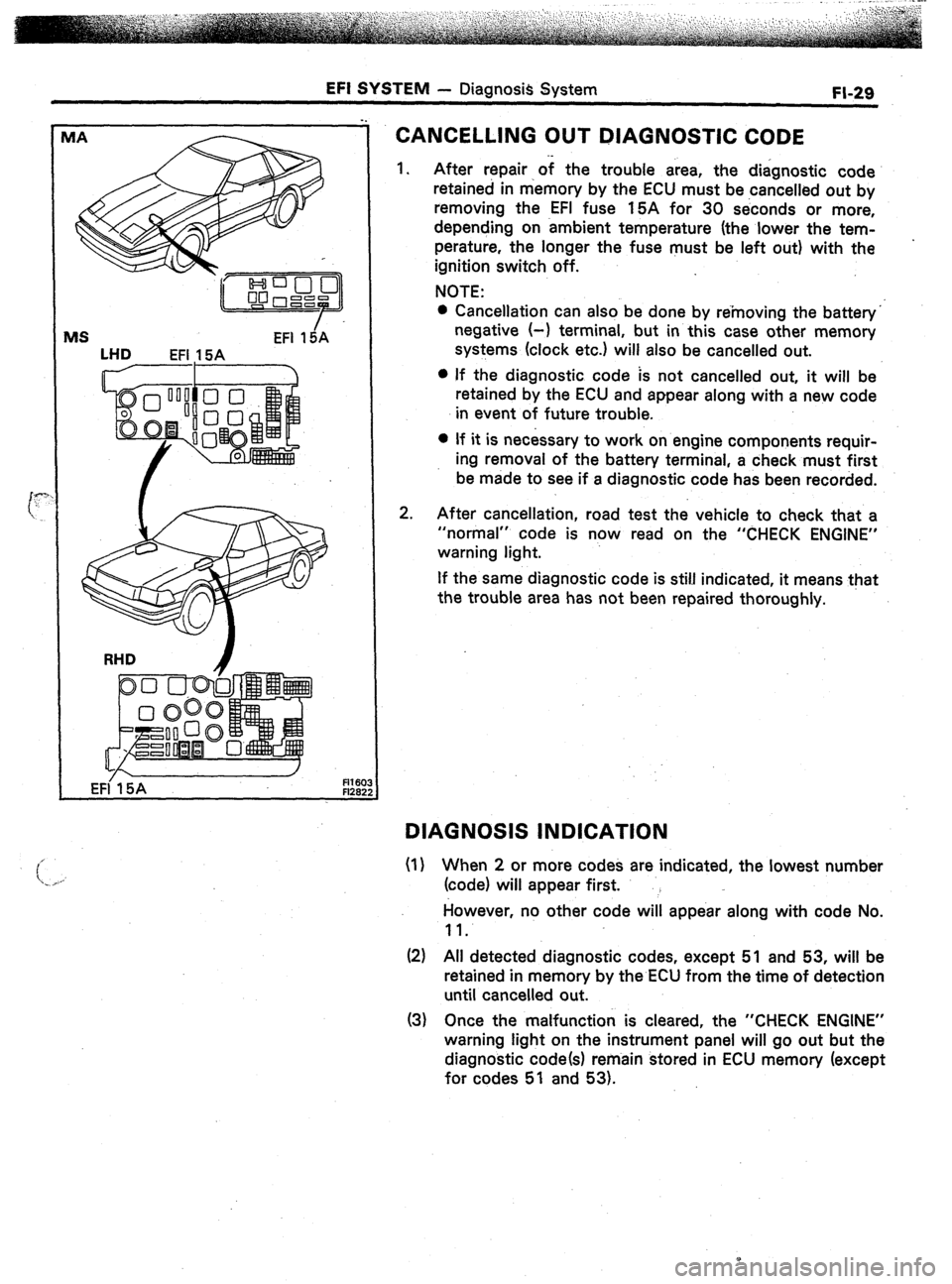
EFI SYSTEM - Diagnosis System FI-29
MS EFI 15iA
LHD
EFI 15A
EFI 15A
R16C
FI26:
CANCELLING OUT DIAGNOSTIC CODE
1.
2. After repair of the trouble area, the diagnostic code
retained in memory by the ECU must be cancelled out by
removing the EFI fuse 15A for 30 seconds or more,
depending on ambient temperature (the lower the tem-
perature, the longer the fuse must be left out) with the
ignition switch off.
NOTE:
l Cancellation can also be done by removing the battery”
negative (-1 terminal, but in this case other memory
systems (clock etc.) will also be cancelled out.
l If the diagnostic code is not cancelled out, it will be
retained by the ECU and appear along with a new code
in event of future trouble.
l If it is necessary to work on engine components requir-
ing removal of the battery terminal, a check must first
be made to see if a diagnostic code has been recorded.
After cancellation, road test the vehicle to check that a
“normal” code is now read on the “CHECK ENGINE”
warning light.
If the same diagnostic code is still indicated, it means that
the trouble area has not been repaired thoroughly.
DIAGNOSIS INDICATION
(I) When 2 or more codes are indicated, the lowest number
(code) will appear first.
However, no other code will appear along with code No.
11.
(2) All detected diagnostic codes, except 51 and 53, will be
retained in memory by the ECU from the time of detection
until cancelled out.
(3) Once the malfunction is cleared, the “CHECK ENGINE”
warning light on the instrument panel will go out but the
diagnostic code(s) remain stored in ECU memory (except
for codes 51 and 53).